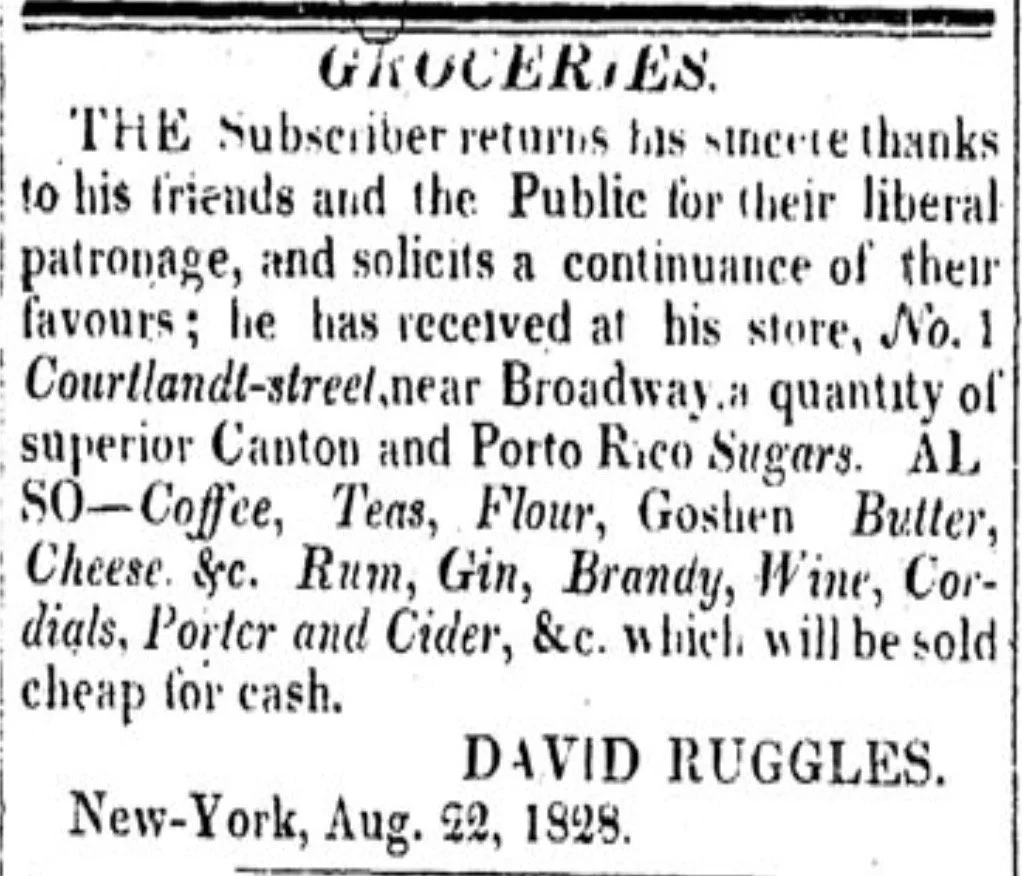Free from the Stain: New York’s Free Produce Stores
By Charline Jao
American proponents of free produce saw clearly the connection between commercial consumption and the institution of slavery, seeking to overthrow what Frances Harper called slavery’s “commercial throne.” Not only did they refuse to buy items that came from southern plantations, they also sought to create new networks of trade, labor, and production. Ruggles, for instance, did not only secure “free” butter from Goshen, New York for his customers, he also employed formerly enslaved men like Samuel Ringgold Ward and Isaiah Harper Ward. Advocates of free produce set out on expeditions to find alternatives to sugar, reached out to farmers and merchants, did speaking tours in England, and opened stores where they could proudly state – as Elizabeth Kent in Pennsylvania did – that they had “EVERYTHING FOR SALE EXCEPTS PRINCIPLES!!”
Read MoreGrand Emporium, Mercantile Monster: The Antebellum South’s Love-Hate Affair with New York City
Review by Emily Holloway
In 1788… a mere 62 bales were shipped to Europe via New York, compared to 153,757 less than thirty years later (2)….Despite the lengthy and arduous journey, tourists, planters, and writers flocked to the city... During their visits, these elite southerners – many of whom owned cotton plantations -- were rubbing elbows with New York’s mercantile and financial leaders,… The close social ties that developed between these classes built on their intimate financial connections through cotton… southern writers remarked critically on the vast economic inequality on display throughout the rapidly growing city, a characteristic they frequently tied to the machinations of industrial capitalism. This critique was frequently deployed as a reaction to northern abolitionist sentiments, a false equivalence between the ravages of industrial “wage slavery” and the racist violence of plantation slavery.
Read MoreAbraham E. Kazan
By Glyn Robbins
Kazan’s efforts, combined with the power of the city’s labor movement and astute political alliance making, led to the building of 40,000 homes for working class New Yorkers. At a time when The Housing Question has rarely been more pressing than since Frederick Engels first raised it in 1872, recognising Kazan’s legacy is important. He successfully developed a model that worked: an alternative to the brutality of the housing market that, despite many challenges, has endured.
Read MoreBound by Bondage: Slavery and the Creation of a Northern Gentry
Review by Emily Holloway
Maskiell argues that both social groups – the enslavers and the enslaved – built, maintained, and challenged their respective terms of community and belonging, whether through diplomacy or corporate mergers disguised as marriage arrangements or by sustaining regional networks of contacts to foment rebellion and resistance. The text at times navigates a vast geographic scale, but successfully keeps the narrative grounded in the roots of elite Dutch society in seventeenth century New Netherlands…The overall book project seeks to illuminate the incremental and cumulative changes along with the continuities linking Dutch colonial practices to English colonial institutions in the transition from New Netherlands to New York.
Read MoreMorganthau: Power, Privilege, and the Rise of An American Dynasty by Andrew Meier
Reviewed by David Huyssen
Henry wasn’t grateful. He hired Pinkerton agents to keep Lazarus away from his wedding. A talented, volcanically ambitious middle son, Henry had been nursing an Oedipal grudge for years. Lazarus had forced him to drop out of City College at fourteen to go to work, and the sting of this betrayal overshadowed the fact that it had also prompted a vital step on Henry’s journey to riches and repute: a job in a law firm run by one of Lazarus’s acquaintances, who initiated him into the world of property management.
Henry rejected his father but embraced his methods.
Read MoreThe Fulton Fish Market: A History
Reviewed by Joshua Specht
From roughly 1850 to 1950, Fulton Market would dominate wholesale fish provisioning in the United States and much of the country’s fish would pass through Fulton…As the market supplied itself from more distant locales, Fulton’s ecological impact widened. … wholesalers had to look further and further away and develop more and more complex means of preserving and moving fish. … the length and complexity of this process served to obscure the ecological impact of food—consumer appetites were, after all, destroying ecosystems a world away.
Read MoreThe Great Kosher Meat War of 1902: Immigrant Housewives and the Riots that Shook New York City
Reviewed by Aaron Welt
With The Great Kosher Meat War of 1902, Scott D. Seligman offers the first book-length treatment of the campaign of Jewish housewives against the “Beef Trust.” … Seligman provides a highly readable chronology of the events between May and June of 1902 that, at the time, earned the title of “a modern Jewish Boston Tea Party” and, later, the Kosher Meat Boycott. He succeeds in bringing to life the largely forgotten and primarily female leaders of the consumer campaign, their roles within the collective effort to bring down the price of kosher beef, the internal divisions that developed, and their significance for American Jews.
Read MoreBefore Central Park
Reviewed by Kara Murphy Schlichting
Before Central Park is Sara Cedar Miller’s fourth publication about New York City’s famous greensward. Miller is historian emerita and, since 1984, a photographer for the Central Park Conservancy. Before Central Park is distinctive in its combination of Miller’s photography, her expert understanding of the park’s geography and archeology, and her meticulous real estate history of parkland from the 17th through the 19th centuries.
Read More







